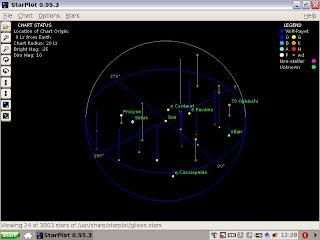First, I've invested in a spare, larger battery - a 6600 mAh one to suppliment the 5200 mAh battery that came with my Eee. Although i suspect the battery to be mislabeled and actually be 7800 mAh, because i got two days of casual use out of it on the first full charge... and later useage seems to conform my theory. Which makes it even funnier that the command cat /proc/acpi/battery/BAT0/info tells me that the battery says it is 4400 mAh, and as such should last significantly shorter than the original. Smile, nod, move on...
Secondly, I found a Maxtor Basic™ 160 Gb external hard drive for a price that couldn't be beat. Just plugged it in and saw the big, empty vistas ahead of me... I've put a few movies on it, along with the full run of a couple of television series. There are still a huge open space there.
Now, as I said, neither of these 'upgrades' are needed as such, and both reduces the portability of the basic Eee. But since my job requires me to do one or two (or, in summer when everyone else has vacation, five) 24 hours dutyshifts a month, they will make those more bearable... just plug in the big battery, plug in the HDD, copy a movie or two to the SD-card, unplug the HDD and lean back to enjoy the show.
Off course, with all this gear my pockets would be bulging, so I started a search for a suitable bag or carrier to carry it in. I might even have found it, and in an unlikely place: The Norwegian Armed Forces Museum's shop in Oslo. It's an old respirator carrier, with pockets that will hold the external hard drive, the cable for the same, my mouse and a couple of USB sticks. In the main room the Eee fits (in it's sleeve) along with my charger, a spare battery and a notepad. And when I go on vacation I'll have room in there for a change of socks too *grin*.
 Result: I can see the relationship between stars in three dimensions, from any point in space.
Result: I can see the relationship between stars in three dimensions, from any point in space.